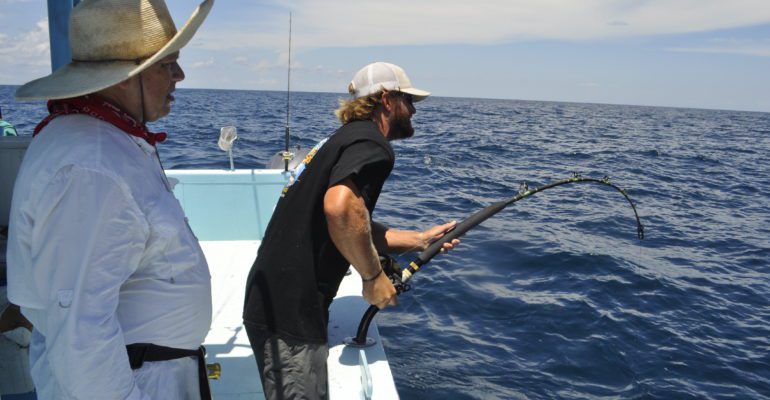Key Message:
- NOAA Fisheries is delaying the implementation of the Gulf of Mexico vessel monitoring system (VMS) requirement for the Southeast For-Hire Integrated Electronic Reporting Program from December 13, 2021, to March 1, 2022.
- The Gulf of Mexico Fishery Management Council requested the VMS requirement with the intention of enhancing recreational catch limit tracking in the Gulf of Mexico; thereby, improving fisheries management.
When the Rule will take effect:
- Regulations requiring VMS for the Gulf of Mexico for-hire permits listed above will be effective March 1, 2022.
What This Means:
- The vessel owners or operators have until March 1, 2022, to install NOAA Fisheries approved hardware and software with GPS capabilities that, at a minimum, archives vessel position data during a trip and transmits those data to NOAA Fisheries.
- The location positioning portion of the hardware must be installed by a certified installer, permanently affixed to the vessel and turned on at all times, unless a power-down exemption is granted.
- The owner or operator of a Gulf of Mexico federally permitted Charter/Headboat vessel must comply with these reporting requirements no matter where the vessel is fishing.
- A list of approved VMS units can be found here: https://www.fisheries.noaa.gov/southeast/rules-and-regulations/approved-vessel-monitoring-system-vms-units-reporting-southeast-hire-integrated.
FORMAL FEDERAL REGISTER PUBLICATION DATE: November 2, 2021.
This bulletin serves as a Small Entity Compliance Guide, complying with section 212 of the Small Business Regulatory Enforcement Fairness Act of 1996.
Where can I find more information on the rule?
- Contact NOAA Fisheries, Southeast Regional Office
By Mail: Rich Malinowski
NOAA Fisheries, Southeast Regional Office
Sustainable Fisheries Division
263 13th Avenue South
St. Petersburg, Florida 33701-5505
By FAX: (727) 824-5308
By Phone: (727) 824-5305
Frequently Asked Questions
What is NOAA Fisheries announcing today?
- NOAA Fisheries published a final rule to delay implementation of the Gulf of Mexico VMS requirement for the Southeast For-Hire Integrated Electronic Reporting Program from December 13, 2021, to March 1, 2022.
- The Gulf of Mexico Fishery Management Council requested all Gulf of Mexico federally permitted for-hire vessels participating in the Southeast For-Hire Integrated Electronic Reporting Program have a VMS installed and operating onboard, thus the agency published a final rule requiring VMS installation/operation by December 13, 2021.
- The Gulf of Mexico Fishery Management Council requested the VMS requirement with the intention of enhancing recreational catch limit tracking in the Gulf of Mexico; thereby, improving fisheries management.
Why is NOAA Fisheries delaying implementation of this rule?
- NOAA Fisheries is delaying implementation of the Gulf of Mexico VMS requirement to allow time for NOAA Fisheries to finish testing a third cellular VMS unit, ensure vessels are equipped with these units before the spring break season in 2022, and provide additional time for litigation to progress.
What are the new requirements effective March 1, 2022?
- Vessel operators will be required to have an approved VMS that includes a GPS device affixed to the vessel that, at a minimum, archives vessel position data for submission to NOAA Fisheries.
How did this rule come about?
- The requirement being implemented by NOAA Fisheries is the result of an amendment that was developed by the Gulf of Mexico Fishery Management Council.
- The Gulf of Mexico Fishery Management Council, which includes for-hire industry participants, chose a vessel position device to help validate effort (fishing trips) and aid in enforcement of reporting requirements.
- The VMS is an additional mechanism requested by the Gulf of Mexico Fishery Management Council that verifies vessel activity without a report having to be completed by the vessel operators.
Why are the new requirements effective March 1, 2022, necessary?
- The ability for NOAA Fisheries to know when a federally permitted for-hire vessel leaves the dock and takes a trip is needed for managers to estimate the total number of for-hire trips and subsequently compare those numbers to the number of trip declarations and logbooks reported.
- Trip Declaration and VMS devices are expected to provide better data on fishing effort (number of trips) and allow for better enforcement of fishing regulations.
- The trip-level reporting could help improve stock assessments by providing a more accurate record of for-hire vessel landings and locations.
Who is required to possess a VMS?
- Owners or operators of vessels with a federal Gulf Charter Vessel/Headboat permit for Reef Fish or a Gulf Charter Vessel/Headboat permit for Coastal Migratory Pelagic species (includes historical captain permits) will be required to have a VMS.
- Since January 5, 2021, submitting trip-level electronic reports has been required regardless of where fishing occurs, including other regions and state waters.
- Owners and operators of vessels that have both a South Atlantic and a Gulf of Mexico federal for-hire permit report to the Gulf of Mexico system to reduce duplicate reporting.
- Owners and operators of vessels that have both a Greater Atlantic or Mid-Atlantic and a Gulf of Mexico federal for-hire permit report to the Gulf of Mexico system for vendors approved for both regions to reduce duplicate reporting.
What equipment do I need and what is that equipment needed for?
- You will be required to have approved hardware and software that meets NOAA Fisheries’ technical requirements and has been approved by NOAA Fisheries.
- Trip Declaration: You can submit your trip declaration through a phone app (iOS or android), tablet, computer, or VMS unit that allows for internet access (satellite or cellular) and is capable of operating an approved software application.
- Logbook: You can submit your logbook through a phone app, tablet, computer, or VMS unit that allows for internet access and is capable of operating approved software.
- Location Validation: A GPS unit will be required that is permanently affixed to the vessel. This can be a cellular-based store-and-forward device or a satellite-based real-time VMS unit.
- Currently NOAA Fisheries has a list of VMS approved units for this program that can be found at: https://www.fisheries.noaa.gov/southeast/rules-and-regulations/approved-vessel-monitoring-system-vms-units-reporting-southeast-hire-integrated.
What if my equipment fails?
- Logbooks and Trip Declarations
- Have a backup – multiple options are available (tablet, PC, cell phone).
- Phone home! You could call your office or home and have someone else submit your logbook.
- Location Devices
- If your VMS device is not functioning, you should first contact the unit’s vendor to see if it can be repaired. If the problem is not remedied, your vessel cannot leave the dock and you would need to contact NOAA Fisheries to notify the staff of the problem.
- NOAA Fisheries is aware of the burden this would create for for-hire businesses that would need to cancel trips. The Gulf of Mexico Fishery Management Council is developing an action that could allow trips to take place in the case of an unexpected equipment failure, under limited circumstances.
- In the commercial sector, VMS failure rate is around 1%; the life of a VMS unit is 5-10 years (depending on brand).
What if I lose my GPS signal?
- For appropriate validation of effort, the units must either have a power-down exemption or be turned on and functional.
- As stated above, if your VMS is not working you should first contact the unit’s vendor to see if the situation can be repaired. If the problem is not remedied, you should notify NOAA Fisheries.
- You may lose a satellite signal if your vessel is in covered storage. If you intend to keep your vessel in covered storage, you should choose a cellular-based unit, which should work anywhere cell phones work.
- If you have a small vessel, you may be concerned about battery drainage. However, many commercial fishermen have smaller vessels with VMS units that do not drain batteries.
What will I be required to do if I am not actively fishing with my permit?
- For logbooks:
- If your vessel does not leave the dock, the location device would inform NOAA Fisheries, and no logbook would be expected for vessels with Gulf of Mexico federal for-hire permits.
- If the vessel leaves the dock but is carrying out non-fishing activities, you would state that in the trip declaration, and no further reporting would be required.
- For location devices:
- A power-down exemption would allow your unit to be turned off as long as your vessel does not move on the water for a minimum of 72 hours.
Where can I find more information about this electronic reporting program, its requirements and the amendment that established the program?





